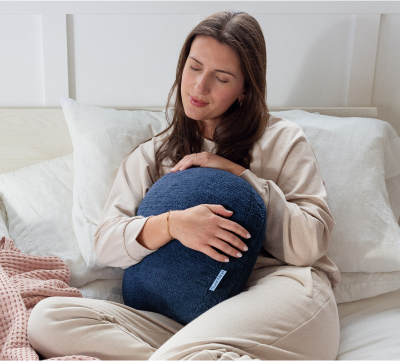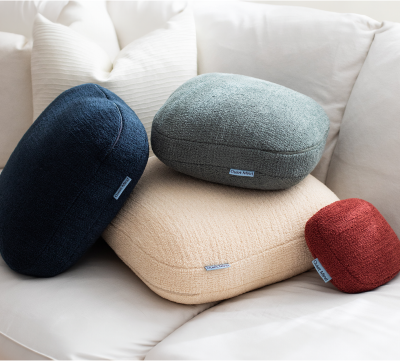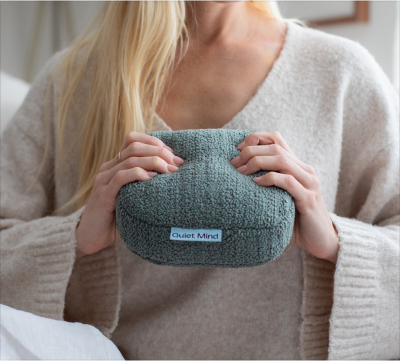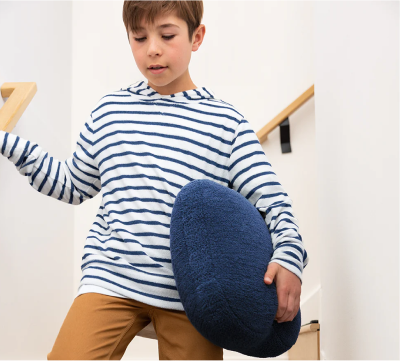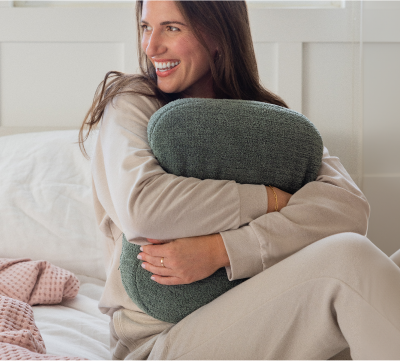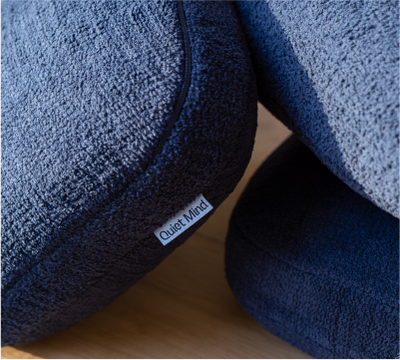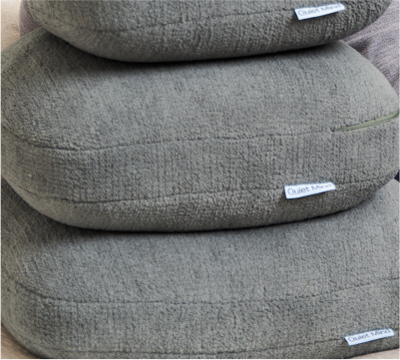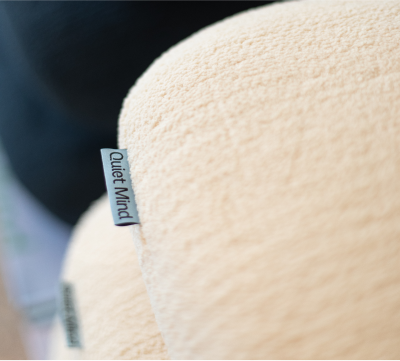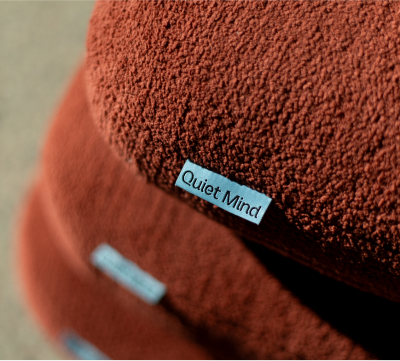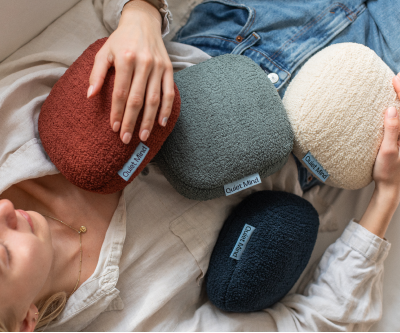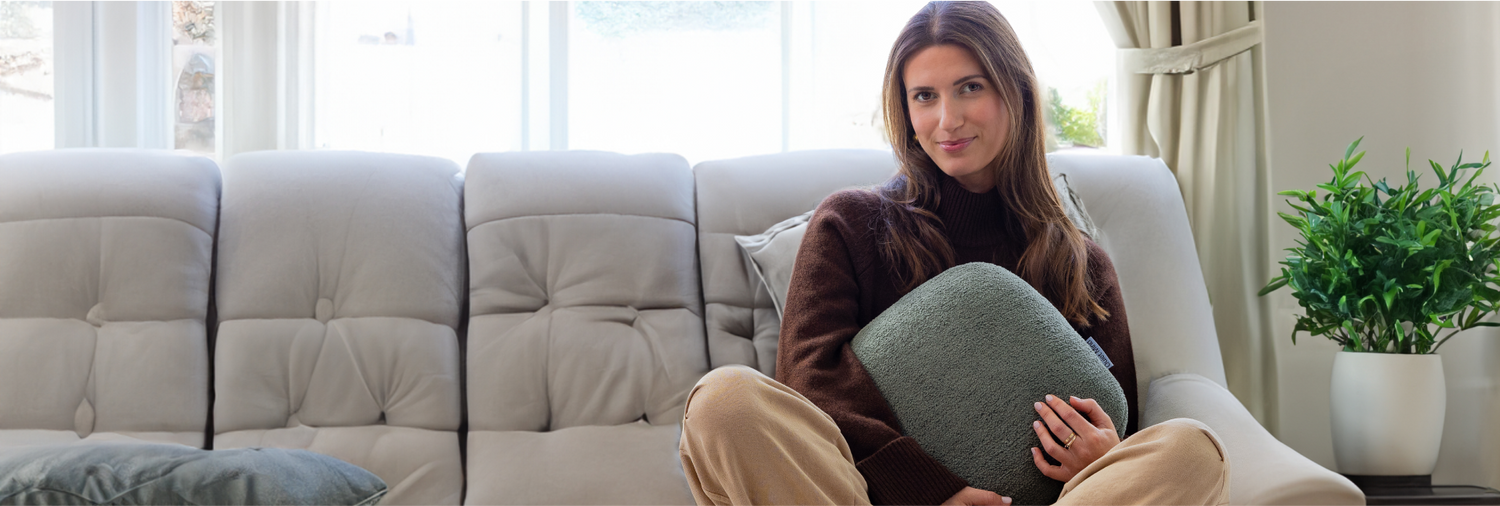Living with arthritis can feel like carrying weight long before you ever crawl into bed. Joint pain lingers into the evening, and stiffness can turn simple rest into a nightly challenge. In those moments, comfort isn’t just nice to have, it’s a lifeline for managing arthritis and protecting your sleep quality.
Weighted blankets have become increasingly common in the wellness space, often praised for their ability to create a calming effect and encourage deeper rest. For someone with arthritis, a weighted blanket can help in two interconnected ways: supporting pain relief through relaxation and improved sleep quality, and making it easier to fall asleep despite discomfort.
The real question is not whether they’re trendy, it’s whether using weighted blankets can be part of an effective pain management plan for your body and your nights.
How Weighted Blankets Work for Arthritis
Weighted blankets work for arthritis by applying deep pressure stimulation. This steady weight can relax muscles and improve circulation around stiff joints. It can also signal the nervous system to reduce pain perception. These combined effects may help the body feel calmer and make rest easier.
What Is Deep Pressure Stimulation?
Weighted blankets work by applying consistent, evenly distributed pressure across the body, a method known as deep pressure stimulation (DPS). This form of sensory input can influence the autonomic nervous system, which helps control stress and relaxation responses.
DPS encourages the release of serotonin and endorphins, brain chemicals linked to mood regulation and pain relief, while lowering cortisol, the body’s main stress hormone. Over time, this may help manage arthritis symptoms by calming overactive nerves, reducing muscle tension, and creating an environment where improved sleep quality is more likely.
When combined with other self-care strategies, the effects of weighted blankets can support both physical comfort and emotional steadiness, making nights less about fighting pain and more about recovering from the day.
Can Weighted Blankets Help With Arthritis Pain?
Arthritis pain isn’t just physical, it’s emotional, cognitive, and cyclical. Pain can disrupt rest, and poor sleep often amplifies joint pain, creating a loop that’s hard to break. Weighted blankets can help interrupt that pattern by combining physical support with emotional reassurance.
Reducing Nighttime Restlessness
The even pressure of a weighted blanket may:
- Lessen tossing and turning, reducing strain on sore joints.
- Provide a sense of safety that encourages the body to relax.
- Calm overactive nerves for a calming effect that lasts beyond bedtime.
- Support deeper, more restorative rest that contributes to pain management.
By improving sleep continuity, research suggests weighted blankets may lower daytime pain sensitivity. The benefits aren’t limited to arthritis alone. Weighted blankets have become a comfort tool for people with multiple health conditions, including anxiety and insomnia, which can both worsen arthritis-related fatigue.
What the Research (and Experience) Suggests
Scientific evidence on using weighted blankets for arthritis is still emerging, but studies on the effects of weighted blankets in related health conditions, such as chronic pain, anxiety, and insomnia, provide useful insight.
Research on deep pressure stimulation shows it can help slow heart rate, reduce cortisol, and improve serotonin production, all of which may support pain relief and better rest. While no single study can confirm that weighted blankets will work for everyone with arthritis, findings suggest that they may improve sleep quality and lower nighttime restlessness, making pain management more achievable.
Clinical observations suggest similar outcomes. Weighted blankets may provide:
- Warmth that eases morning stiffness.
- A more settled feeling when falling asleep.
- Emotional comfort during flare-ups.
- Support for managing arthritis when combined with other strategies like heat therapy or gentle stretching.
These personal experiences, combined with early research, suggest that blankets can help some individuals feel calmer and more in control of their symptoms.
What Medical Professionals Say About Weighted Blankets and Arthritis
Many experts agree that no single remedy works for everyone. But many see weighted blankets as a low-risk, potentially soothing tool, when used mindfully.
Insights from Rheumatologists and Pain Specialists
Experts agree: there is no single “cure-all” for arthritis. But many, including Dr. Neal Walia of UCLA Health, sees weighted blankets as a low-risk option for improving rest and easing stress when used thoughtfully.
Dr. Walia notes that the gentle, even pressure may help calm the nervous system before sleep, which for some people can make nighttime discomfort more manageable.
Rheumatologists emphasize that, while weighted blankets can be part of a broader comfort plan, they should never replace prescribed arthritis treatments. They also recommend caution during severe flare-ups or when significant mobility issues are present.
In these cases, partial coverage, such as draping the blanket over the legs or torso only, or using a lighter model, may be more comfortable and easier to manage.
The Role of Occupational Therapists
Occupational therapists often include weighted blankets in personalized comfort strategies.
An OT can also help you adjust placement to avoid inflamed joints, explore breathable fabrics to reduce overheating, and track comfort over time to ensure the blanket remains supportive rather than restrictive.
The Royal College of Occupational Therapists (RCOT) released an official guide highlighting the need for risk assessment, safe use practices, and monitoring outcomes. This resource is not only for professionals, it’s also helpful to individuals considering weighted blankets for sensory or physical comfort, ensuring safe and supportive use.
Which Types of Arthritis May Benefit From Weighted Blankets?
Weighted blankets may be most helpful for arthritis types that involve joint stiffness, muscle tension, or difficulty relaxing at night. The gentle, steady pressure can support comfort and ease before and during sleep.
Not all arthritis affects the body in the same way, so the potential benefits of weighted blankets vary by type. The goal is to match the effects of weighted blankets to your specific needs.
Osteoarthritis and Sleep Disruption
With osteoarthritis, due to pain from joint wear and tear, nights can feel longer and more fragmented. Weighted blankets can help by:
- Encouraging stillness and reducing nighttime movement.
- Providing gentle warmth that eases stiffness.
- Supporting serotonin release to soften pain perception.
|
Benefit |
How It Helps Osteoarthritis |
|
Improved sleep quality |
Less movement = deeper, more restorative rest |
|
Calming pressure |
May reduce discomfort and racing thoughts |
|
Emotional regulation |
Supports mood and resilience during flare-ups |
Rheumatoid Arthritis and Emotional Strain
Rheumatoid arthritis often comes with systemic inflammation and emotional fatigue. Weighted blankets may provide:
- Reduced anxiety through steady, grounding pressure.
- Support for serotonin production, improving mood.
- Better rest, which can help regulate immune function and manage arthritis symptoms.
Psoriatic Arthritis and Nighttime Discomfort
Psoriatic arthritis can cause joint pain, swelling, and stiffness that disrupt sleep. Weighted blankets may help by:
- Providing even, soothing pressure to ease muscle tension.
- Helping the body relax despite flare-ups.
- Supporting better sleep quality, which can reduce fatigue.
Ankylosing Spondylitis and Morning Stiffness
Ankylosing spondylitis often affects the spine and can lead to stiffness overnight. Weighted blankets may:
- Support stillness, reducing morning discomfort.
- Relax surrounding muscles for easier sleep.
- Create a sense of comfort that helps with pain management.
Used thoughtfully, weighted blankets provide both physical and emotional comfort, making them a valuable addition to a personalized arthritis care plan.
What are the Pros and Cons of Using a Weighted Blanket With Arthritis?
Weighted blankets can be a powerful tool for comfort, but they’re not right for everyone. Understanding both benefits and risks can help you decide if they’re a good fit for your pain management plan.
Benefits: Calm, Comfort, and Rest
- Deep relaxation: The gentle, steady pressure may help lower cortisol and activate the body’s relaxation response, leading to improved sleep quality.
- Gentle warmth: Retains body heat that can ease stiffness, especially in cooler rooms or during early morning hours.
- Pain relief support: Reduced restlessness can help limit nighttime joint strain, making it easier to fall asleep and stay asleep.
|
Benefit |
Description |
|
Relaxation |
Helps calm the nervous system and support managing arthritis symptoms |
|
Warmth |
Soothes sore joints and reduces morning stiffness |
|
Better sleep |
Encourages stillness, which supports recovery |
Drawbacks: Too Much Pressure
Even weighted blankets that come in lighter versions can feel uncomfortable for some arthritis patients.
- Inflamed joints may be sensitive to weight during flare-ups.
- Mobility limitations may make repositioning under the extra weight difficult.
- Pressure on the wrong areas (shoulders, hips) can worsen discomfort.
|
Concern |
Consideration |
|
Joint sensitivity |
Use partial coverage to avoid tender areas |
|
Limited movement |
Choose lighter weights or a throw-sized blanket |
|
Flare-up discomfort |
Switch to heat pads or lighter layers during active inflammation |
Comparing Weighted Blankets to Other Arthritis Sleep Aids
Relief is personal. What soothes one body may not suit another. Here’s how weighted blankets compare to other popular sleep supports:
|
Sleep Aid |
Primary Benefit |
Arthritis Symptom Relief |
|
Weighted Blankets |
Deep pressure stimulation |
Reduces anxiety, promotes sleep |
|
Heated Blankets |
Warmth and muscle relaxation |
Eases stiffness and joint tension |
|
Orthopedic Pillows |
Spinal alignment |
Reduces pressure on neck, shoulders, and hips |
|
Mattress Toppers |
Surface support |
Minimizes pressure points across the body |
Many people benefit from combining tools, for example, using a heated mattress pad with a lightweight weighted throw.
How to Choose the Right Weighted Blanket for Arthritis
Not all weighted blankets are created equal. The right one balances weight, breathability, and softness so it can support comfort without adding strain. What’s inside a weighted blanket matters just as much as how it feels on the outside, fill type, fabric, and overall design all influence how it performs for someone managing arthritis.
Recommended Weight, Fill Type, and Fabric
- Weight: Start with 8–10% of your body weight, or even less if your joints are especially tender. This ensures gentle pressure without overloading sensitive areas.
- Fill Type: Glass beads tend to feel smoother and more evenly distributed inside a weighted blanket compared to plastic pellets, making them less likely to create uneven pressure points.
- Fabric: Breathable materials like cotton or bamboo are ideal for temperature control and for skin that’s prone to sensitivity or irritation.
|
Feature |
Best For Arthritis |
|
Weight (8–10%) |
Gentle pressure without overload |
|
Glass Beads |
Smoother, more balanced feel |
|
Bamboo/Cotton |
Breathable, low-friction comfort |
Fabric Matters for Sensitive Skin
If you live with inflamed or easily irritated skin, the texture and breathability of a weighted blanket can be just as important as its weight. Coarse or heat-trapping fabrics can create unnecessary friction, cling to the skin, or cause overheating, issues that may feel even more uncomfortable during arthritis flare-ups.
Choosing a cover made from breathable materials like cotton helps air circulate, regulates body temperature, and provides a smooth, low-friction surface that won’t aggravate sensitive areas.
The weave and construction of the fabric also play a role in comfort. Softer, tightly woven fabrics glide easily over the skin, while removable, machine-washable covers make it easier to keep the blanket clean without exposing sensitive skin to harsh detergents or rough drying cycles.
Quiet Mind’s designs pair skin-kind fabrics with evenly distributed fill inside the pillow cover, so the calming pressure stays consistent without adding irritation, helping you focus on comfort and rest.
Quiet Mind’s Safety Tips for Using a Weighted Blanket for Arthritis
Safety isn’t just about choosing the right weight, it’s about paying attention to how your body responds and making small adjustments over time. A blanket that feels comfortable one week may feel too heavy during a flare-up, so flexibility is key.
Adjusting Blanket Placement
Placing the full weight directly on sore or swollen joints can increase discomfort. Instead, position the blanket so its pressure supports comfort rather than aggravating sensitive areas:
- Torso only: Rest the blanket across your chest, stomach, or hips to create calming pressure without stressing your joints.
- Legs only: Cover from the thighs down to soothe restless legs, reduce knee discomfort, and avoid upper body strain.
- Folded for targeted use: Folding the blanket allows you to localize the weight over one area, such as across your lap or lower back, so you receive the benefit of deep pressure without overloading the entire body.
When Partial Coverage Is Better
Partial coverage can be just as effective as full-body use, particularly during times of inflammation or reduced mobility. This approach gives you the grounding sensation of a weighted blanket while protecting vulnerable joints.
|
Placement |
Benefit |
|
Legs Only |
Soothes restless legs and knee pain |
|
Torso Only |
Encourages calm without adding shoulder or neck strain |
|
Partial Body |
Offers comfort while avoiding pressure on sore joints |
Listening to your body’s feedback, whether that’s warmth, pressure, or ease of movement, will help you fine-tune your use of a weighted blanket so it remains a source of relief rather than discomfort.
When Weighted Blankets Might Not Be Suitable for Arthritis
Weighted blankets can be a valuable comfort tool for many people living with arthritis, but they are not the right choice for everyone. During periods of severe joint inflammation, intense pain, or significant mobility limitations, the extra weight may place more strain on your body than relief.
In these moments, the priority should be reducing stress on your joints, preserving your ability to shift positions easily, and maintaining steady, comfortable breathing.
Assessing Your Condition First
Before using a weighted blanket, take a moment to check in with your body:
- Are your joints currently swollen, tender, or warm to the touch?
- Do you find it difficult to roll over, adjust your position, or sit up in bed without assistance?
- Does even light pressure on certain areas cause discomfort?
If you answer “yes” to any of these questions, it’s worth starting with lighter alternatives—such as a throw-sized weighted blanket, a weighted pillow for targeted pressure, or a heated wrap for joint comfort. You can also wait until flare-ups subside before reintroducing a heavier blanket into your routine.
Seeking Professional Guidance
Occupational therapists and rheumatologists can help you decide whether a weighted blanket is suitable for your arthritis, and guide you on how to use it safely. This might include choosing a lower weight than the standard 8–10% guideline, adjusting placement to avoid sensitive joints, or selecting breathable fabrics to prevent overheating.
Professional input can also help you adapt the blanket for partial coverage, using it over the legs or torso only, so you still receive calming deep pressure without unnecessary strain on your body.
Final Thoughts
Weighted blankets can be a comforting and soothing tool for those managing arthritis, offering the potential for better sleep, pain relief, and emotional support. While not suitable for everyone, their calming pressure can make a meaningful difference in your rest and overall well-being when used mindfully.
Always listen to your body and consult healthcare professionals to find the right fit, ensuring safety and comfort during flare-ups or mobility limitations. With the right weight, fabric, and placement, weighted blankets can be an essential part of your comfort routine.
About Quiet Mind
At Quiet Mind, we believe that true comfort goes beyond relaxation, it’s about creating a safe space for your body and mind to recharge. We specialize in thoughtfully designed products that promote emotional regulation, restful sleep, and stress relief.
Our weighted pillows are crafted with skin-kind fabrics and evenly distributed pressure, providing targeted comfort and support for your body while ensuring a soothing, restful experience without causing discomfort. Whether you’re seeking comfort during the day or a calming night’s rest, Quiet Mind helps you create moments of stillness, one soothing touch at a time.
Frequently Asked Questions
Can weighted blankets help alleviate arthritis pain?
They may. While weighted blankets don’t treat the underlying causes of arthritis, they can help reduce nighttime restlessness, calm overactive nerves, and encourage more consistent sleep, which often leads to lower pain sensitivity during the day.
Are weighted blankets suitable for all types of arthritis?
They can benefit some people with osteoarthritis or rheumatoid arthritis, especially when anxiety, insomnia, or stiffness are part of the picture. However, individual tolerance varies, and the weight should be adjusted to your comfort and mobility.
How do I choose the right weighted blanket for arthritis?
Choose a blanket that’s about 8–10% of your body weight, or lighter if your joints are sensitive. Glass bead fillings and breathable fabrics like cotton or bamboo can improve comfort. Avoid heavy, heat-trapping materials during warmer months.
Can weighted blankets worsen arthritis symptoms?
Yes, if they place too much pressure on inflamed joints or limit movement. Monitor your body’s response closely and opt for partial coverage when needed.
How can I use a weighted blanket safely with arthritis?
Avoid draping it over actively swollen joints. Try covering only your legs or torso, and adjust throughout the night if discomfort appears. Breathable fabrics and lighter weights make it easier to manage.
